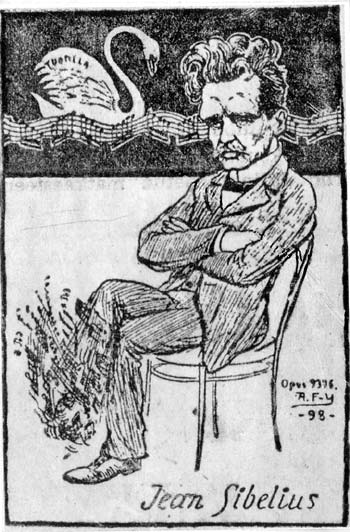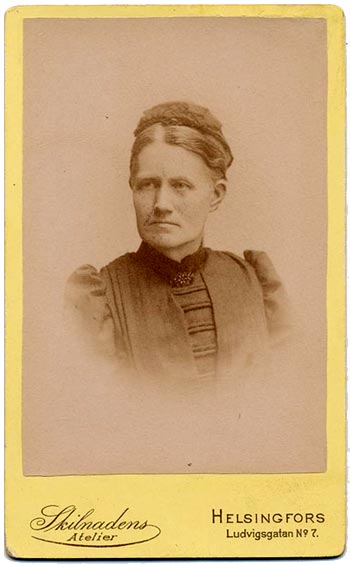In 1897 Sibelius was hard at work, but receiving very little acknowledgement. At the beginning of the year he completed the excellent Degree Ceremony Cantata, then during a journey to Italy in the summer, and in Lohja and Helsinki, he composed a piece for baritone and orchestra called The Rapids-Shooter’s Brides. It was received moderately well at a concert on 1st November 1897, but it was the revised version of the Lemminkäinen Suite that attracted all the attention. Once again Merikanto praised the work and the public was utterly captivated, but the critic Karl Flodin denounced Sibelius's style in a notorious review.
"This kind of music feels downright pathological and the impressions it leaves are so confused, painful and vague that they have very little in common with that aesthetic pleasure which all fine arts and music in particular should awaken," he thundered.
"The Lemminkäinen depictions depress me; they make me unhappy, fragmented and apathetic. Is it the purpose of music to awaken such moods?"

A. Federley's cartoon of the composer of the
Swan of Tuonela, 1898.
One can understand Sibelius's frustration. He had already composed some works of an extremely high international level, including Kullervo, En Saga, the early versions of the Karelia Suite and the Lemminkäinen Suite. But the scores of the orchestral works had not even been published; nor had any of his compositions attracted attention abroad. Moreover, Flodin's destructive criticism was hurtful to Sibelius. He authorised the release of only two movements of the excellent Lemminkäinen Suite (The Swan of Tuonela and Lemminkäinen's Return). It was only several decades later that he was persuaded to publish the whole suite. In the midst of all this misery the composer's mother died, on the 29th December 1897. She was not to witness her son's spectacular rise to international fame only a few years later.

Maria Sibelius, the composer's mother
Then came a sudden turn for the better. Sibelius was awarded an annual arts grant of 3,000 marks for a period of ten years (about 9,000-11,000 euros per year in today’s money). Later, Sibelius came to believe that Kajanus had fixed the grant for him, as compensation for taking the post as the university music teacher. The grant was about half of a professor's salary. Later, at the end of the ten-year period, the grant was changed to a lifelong pension, but inflation started to nibble at the sum. The grant did not solve Sibelius’s economic problems, but it did give him the courage to take on less and less teaching.
The situation eased further when Sibelius composed the music to Adolf Paul's play King Christian II. The premiere was on the 24th February 1898 and the stage music included fine pieces that stuck in the memory, including the Elegy and The Song of the Cross-Spider. The Musette from the suite had such a catchy lilting tune that people in Helsinki sang it to the words
"Now I’m off to Kämp again." A century later, when the luxury Hotel Kämp was reopened in the late 1990s, the Musette was used as its telephone call-waiting tune.
An old music companion of Sibelius, the critic Karl Fredrik Wasenius (who wrote for Hufvudstadsbladet under the pen name
"Bis") undertook to publish four pieces from the stage play: the Elegy, Musette, Minuet and The Song of the Cross-Spider. He paid for them to be printed as piano arrangements by Breitkopf & Härtel in Leipzig. They were distributed in Finland and sold well.
Sibelius travelled with his wife to Berlin at the end of February, right after the premiere of the stage music. Aino, who was pregnant, returned quickly, but Sibelius continued his stay in the metropolis. Aino wrote to him, warning him not to drink too much.
"Janne, it may be that you are right on the borderline and that if you do not turn yourself round now, you will become strange and really unpleasant in that respect."
The stay in Germany proved worthwhile. Adolf Paul urged Sibelius to go with him to Leipzig to meet Oskar von Hase, the director of Breitkopf & Härtel, the company that had previously printed the stage music for King Christian II. The company now decided to buy the rights to the stage music for distribution in Germany. At last Sibelius had contacts with an international publisher.
During the summer of 1898, Sibelius prepared his stage music while staying in Lohja. Wasenius had the orchestral scores printed. He was terrified at the expense, but Breitkopf & Härtel began to distribute them in Germany.
Life went on in other ways: in November Sibelius’s third daughter Kirsti was born in Helsinki, and in December the orchestral suite King Christian II had a good reception in Helsinki.
"The music sounded excellent and the tempi seem to be right. I think this is the first time that I have managed to make something complete," the composer wrote.
With the music for King Christian II Sibelius attracted some attention beyond Finland. As early as February 1899 the play was successfully performed in Stockholm, although the orchestra was too small. In the same month, the music was performed in Leipzig, where it was conducted by Hans Windersten. The newspaper Leipziger Anzeitung called the work
"a trifle", which irritated the composer. He would have liked to introduce himself to the city with a work on a larger scale.
Such a work was on its way: in January 1899 Sibelius moved to Kerava to avoid the temptations of the capital and to work on his first symphony. His patriotic feelings were aroused when on the 15th February 1899 Nicholas II, the Emperor of Russia, issued a
"February Manifesto" which aimed to restrict the autonomy of the Grand Duchy of Finland. The manifesto assumed powers over all the nations within the Russian empire, leaving the Finnish Parliament nothing but a consultative role. The Finnish-speaking and Swedish-speaking cultural circles joined together to oppose the manifesto.
While he was at work on the symphony, Sibelius composed The Song of the Athenians. The words could easily be interpreted as a declaration against Russian oppression. The symphony and The Song of the Athenians had their first public performance in Helsinki on the 26th April 1899. huhtikuuta. The song aroused the enthusiasm of the public and made Sibelius one of the leading figures of national resistance. The symphony for its part delighted the critics, including Richard Faltin and Oskar Merikanto. From being a controversial figure Sibelius had become a national hero.
Sibelius continued in the role of protest-composer. In October 1899 he completed The Breaking of the Ice on Oulu River, a work for spoken narrator, choir and orchestra. The text had previously been written in honour of Tsar Alexander II, so the Russian governor-general Nicholas Bobrikov could not ban the performance of the work.The Finnish audience easily recognised the spirit of protest it embodied.
The next protest work was heard in November. Sibelius composed the music for tableaux connected with celebrations for the Finnish Press. The music was excellent, and Sibelius used it later. First of all he adapted the concluding piece, Finland Awakens, as a separate piece, called Finlandia. Then in 1911 he used other pieces from the tableaux – those he was most satisfied with – to create a suite for orchestra, Scènes Historiques I.
"I wonder what this new century will bring for Finland and the Finns," Sibelius wrote to his wife on New Year's Day 1900.
"At least it will not be on us Finns that the judgement of history will fall. And the fact that our cause is just will give us dignity and peace of mind."

